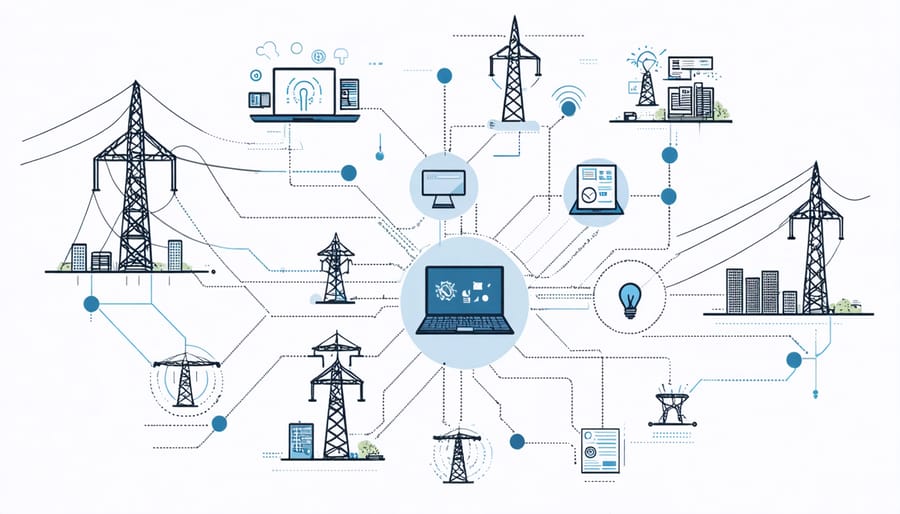Digital transformation revolutionizes utility operations, driving unprecedented efficiency gains of 25-40% across power generation, transmission, and distribution networks. Forward-thinking utility companies leverage advanced analytics, IoT sensors, and AI-powered grid management to optimize performance while creating new renewable energy career opportunities. This technological shift demands a strategic approach to workforce development, with 82% of utility leaders citing digital skills as critical for future success.
Modern utilities must embrace cloud computing, data analytics, and automated workflow systems to remain competitive in an increasingly distributed energy landscape. Real-time monitoring capabilities, predictive maintenance algorithms, and customer engagement platforms now form the backbone of successful utility operations. These digital tools not only enhance operational efficiency but also enable utilities to better integrate renewable energy sources, respond to demand fluctuations, and deliver superior customer service.
By implementing comprehensive digital transformation strategies, utilities position themselves to tackle emerging challenges in grid modernization, cybersecurity, and sustainable energy integration while creating substantial value for stakeholders and customers alike.
The Digital Revolution in Utility Operations
Smart Grid Technologies
Managing modern smart grids requires a sophisticated set of digital skills that combine traditional utility knowledge with advanced technological capabilities. Utility professionals must now master data analytics platforms to monitor real-time grid performance, interpret consumption patterns, and predict maintenance needs. These systems generate vast amounts of data that require expertise in visualization tools and predictive modeling software.
Key competencies include proficiency in SCADA systems, distribution management systems (DMS), and advanced metering infrastructure (AMI). Engineers and technicians need to understand IoT sensor networks, cyber security protocols, and automated control systems to ensure grid reliability and safety. Cloud computing skills are essential for managing distributed energy resources and implementing demand response programs effectively.
Remote monitoring capabilities have become crucial, with professionals requiring expertise in mobile applications and remote diagnostic tools. Grid operators must also develop skills in integration platforms that connect various grid components and facilitate seamless communication between different systems. Understanding artificial intelligence and machine learning applications helps optimize grid performance and enhance decision-making processes in real-time operations.

Data Analytics and Asset Management
Data analytics has become a cornerstone of modern utility operations, enabling organizations to make informed decisions based on real-time insights. Advanced analytics platforms now process vast amounts of data from smart meters, IoT sensors, and grid infrastructure to optimize performance and predict maintenance needs. This data-driven approach allows utilities to reduce operational costs while improving service reliability.
Digital asset management systems have revolutionized how utilities track and maintain their infrastructure. These platforms provide comprehensive visibility into asset lifecycles, from installation to retirement, while enabling predictive maintenance strategies that prevent costly failures. Using artificial intelligence and machine learning algorithms, utilities can now forecast equipment degradation and schedule maintenance activities proactively.
The integration of geographic information systems (GIS) with asset management platforms has enhanced spatial analysis capabilities, allowing utilities to better understand their network topology and optimize resource deployment. Real-world applications include using smart meter data to identify power theft, predicting equipment failures before they occur, and optimizing crew dispatching during outages.
Success in this area requires developing competencies in data visualization, predictive analytics, and digital twin technology, ensuring utilities can fully leverage their digital investments while maintaining high service standards.
Essential Digital Competencies for Renewable Energy Workers
Remote Monitoring and Control Systems
The evolution of remote monitoring and control systems has become a cornerstone of modern utility operations, particularly in the context of workforce development in renewables. Today’s utility professionals must master sophisticated SCADA systems, data analytics platforms, and automated control interfaces to effectively manage renewable energy assets.
Key operational skills include proficiency in real-time performance monitoring, predictive maintenance systems, and remote troubleshooting capabilities. Operators need to understand complex data visualization tools and be able to interpret key performance indicators (KPIs) to optimize system efficiency. This requires a blend of traditional electrical knowledge and modern digital competencies.
Critical competencies include cybersecurity awareness, as remote systems are increasingly vulnerable to digital threats. Professionals must understand secure access protocols, data encryption standards, and incident response procedures. Additionally, expertise in cloud-based management platforms and mobile applications has become essential for modern utility operations.
Communication skills are equally important, as operators often need to coordinate with multiple stakeholders across different locations. Proficiency in digital collaboration tools and remote team management software enables effective system oversight and rapid response to operational challenges. These skills are particularly crucial during emergency situations or when implementing system upgrades.
Success in this field requires continuous learning and adaptation to emerging technologies, as automation systems and control interfaces evolve rapidly. Regular training and certification programs help ensure operators maintain current knowledge of best practices and industry standards.

Digital Maintenance and Diagnostics
Digital maintenance and diagnostics represent a cornerstone of modern utility operations, revolutionizing how organizations approach equipment maintenance and system reliability. Through the implementation of IoT sensors, advanced analytics, and machine learning algorithms, utilities can now predict potential failures before they occur, significantly reducing downtime and maintenance costs.
Predictive maintenance systems continuously monitor equipment performance metrics, including temperature, vibration, and electrical signatures. This real-time data collection enables utilities to establish baseline performance patterns and identify anomalies that may indicate impending issues. For example, a major European utility reported a 25% reduction in maintenance costs after implementing AI-driven predictive maintenance across their power distribution network.
Digital diagnostic tools have evolved to include augmented reality (AR) applications that guide technicians through complex repair procedures. These solutions provide step-by-step instructions overlaid on physical equipment, reducing repair times and minimizing human error. Remote diagnostics capabilities allow experts to troubleshoot issues from centralized locations, dramatically improving response times and resource allocation.
Cloud-based maintenance management systems integrate these technologies into comprehensive platforms that track maintenance schedules, equipment histories, and performance trends. This digital ecosystem enables utilities to optimize maintenance intervals, automate work orders, and make data-driven decisions about equipment replacement or upgrades. The result is enhanced operational efficiency, improved asset longevity, and substantial cost savings across the utility infrastructure.
Energy Management Software
Effective utilization of advanced energy management platforms requires a comprehensive set of digital competencies that combine technical expertise with analytical capabilities. Personnel must demonstrate proficiency in data analysis, system integration, and real-time monitoring techniques to maximize the potential of these sophisticated tools.
Key competencies include the ability to interpret complex energy consumption patterns, configure automated control systems, and implement demand response strategies. Professionals should be skilled in dashboard manipulation, report generation, and the interpretation of key performance indicators (KPIs) related to energy usage and efficiency metrics.
Understanding of API integration and data security protocols is essential, as modern energy management platforms often interface with multiple systems and handle sensitive operational data. Facility managers and energy specialists need to master predictive maintenance features, load forecasting tools, and optimization algorithms to make informed decisions about energy distribution and consumption.
Additionally, professionals should develop expertise in:
– Building automation system (BAS) integration
– Energy analytics and benchmarking
– Fault detection and diagnostics
– Cost analysis and budget optimization
– Regulatory compliance monitoring
– Sustainability reporting
Organizations implementing these platforms should invest in continuous training programs to ensure staff maintain current knowledge of system updates and emerging features. This includes regular workshops, certification programs, and hands-on training sessions with platform vendors to maximize the return on investment in energy management technology.
Implementing Digital Skills Training Programs
Training Frameworks and Certifications
The digital transformation of utilities requires a robust framework of training and certification programs to ensure workforce readiness. Leading organizations like the Utility Technology Association (UTA) and Grid Operations Institute offer comprehensive renewable energy training programs that combine traditional utility operations with digital competencies.
Key certification paths include Digital Asset Management (DAM) certification, Smart Grid Operations Specialist (SGOS), and Utility Analytics Professional (UAP). These programs typically span 6-12 months and incorporate hands-on experience with industry-standard software platforms and IoT systems.
Many utilities are partnering with technical institutions to develop customized training modules that address their specific digital transformation needs. These programs often include:
– Advanced metering infrastructure management
– Predictive maintenance systems
– Digital customer engagement platforms
– Cybersecurity protocols
– Data analytics and visualization
Industry leaders recommend a tiered approach to certification, starting with foundational digital skills and progressing to specialized areas like artificial intelligence and machine learning applications. Organizations should also consider implementing continuous learning programs to keep pace with rapidly evolving technology.
Professional associations such as the International Utility Digital Transformation Council provide additional resources, including workshops, webinars, and peer networking opportunities, helping utilities build comprehensive digital competency frameworks aligned with industry standards.
Real-World Implementation Cases
Several leading utility companies have successfully implemented digital transformation initiatives, providing valuable insights for the industry. Florida Power & Light demonstrated remarkable success by deploying smart grid technology and advanced analytics, resulting in a 25% reduction in outage times and improved customer satisfaction scores by 35% over three years.
Duke Energy’s implementation of predictive maintenance systems using IoT sensors and AI algorithms has reduced equipment failures by 40% and decreased maintenance costs by $30 million annually. Their mobile workforce management platform has also improved field technician efficiency by 23%.
Con Edison’s digital customer engagement platform serves as another exemplary case, handling over 70% of customer interactions through digital channels and reducing call center volume by 45%. Their implementation of blockchain technology for peer-to-peer energy trading has enabled more efficient renewable energy integration.
The UK’s National Grid’s digital transformation journey focused on cybersecurity and data analytics, resulting in a 60% improvement in threat detection and a 28% reduction in energy losses across their transmission network. Their success emphasizes the importance of a comprehensive security framework in digital initiatives.
These implementations share common success factors: clear strategic alignment, strong change management programs, comprehensive employee training, and phased deployment approaches. Companies that prioritized employee engagement and cultural transformation alongside technological implementation showed notably better results in their digital transformation efforts.
Future-Proofing the Utility Workforce
Emerging Technologies and Skills
The digital transformation of utilities is driving unprecedented demand for new technological competencies and skillsets. As the future of renewable energy jobs evolves, professionals must master emerging technologies like artificial intelligence, IoT sensors, and advanced analytics platforms. Cloud computing and edge computing solutions are becoming fundamental requirements, enabling real-time data processing and predictive maintenance capabilities.
Key emerging technologies include digital twins for asset management, blockchain for peer-to-peer energy trading, and machine learning algorithms for grid optimization. Cybersecurity expertise is increasingly critical as utilities modernize their infrastructure and integrate smart technologies.
To remain competitive, organizations must prioritize upskilling programs focusing on data science, automation, and digital project management. Cross-functional knowledge spanning both traditional utility operations and modern digital systems is becoming essential. Professionals should develop competencies in agile methodologies, digital collaboration tools, and customer experience platforms to drive successful digital transformation initiatives.

Building Adaptable Teams
Building a digitally resilient workforce requires a strategic approach that combines technological proficiency with adaptable mindsets. Successful utility digital transformation depends on teams that can navigate evolving technologies while maintaining operational excellence. Organizations should focus on developing cross-functional capabilities, where team members understand both traditional utility operations and digital solutions.
Implementation begins with a skills assessment to identify gaps and opportunities. Create personalized learning paths that blend technical training with soft skills development. Emphasize continuous learning through mentorship programs, regular workshops, and hands-on experience with new digital tools. Consider establishing digital champions within teams to accelerate adoption and provide peer support.
Change management plays a crucial role in building adaptable teams. Regular communication about digital initiatives, clear performance expectations, and recognition of digital achievements help create a culture of innovation. Organizations should also foster collaboration between IT and operational teams to ensure seamless integration of new technologies.
Invest in future-ready skills by encouraging certifications in relevant technologies and creating opportunities for cross-departmental projects. This approach ensures teams remain agile and prepared for ongoing digital evolution in the utility sector.
Digital transformation in the utility sector represents a fundamental shift that companies must embrace to remain competitive and efficient in today’s rapidly evolving energy landscape. The journey toward digitalization requires a strategic approach combining technological innovation, workforce development, and organizational change management.
Key success factors include establishing a clear digital roadmap, securing leadership buy-in, and implementing comprehensive training programs. Utility companies should prioritize investments in core digital technologies such as advanced metering infrastructure (AMI), smart grid solutions, and data analytics platforms while ensuring cybersecurity measures are robust and continually updated.
To initiate transformation effectively, organizations should:
– Conduct thorough digital maturity assessments
– Develop phased implementation plans with measurable milestones
– Create cross-functional teams to drive digital initiatives
– Invest in employee upskilling and reskilling programs
– Establish partnerships with technology providers and industry experts
The future of utilities lies in their ability to leverage digital technologies to enhance operational efficiency, improve customer experience, and support the integration of renewable energy sources. Companies that act decisively now will be better positioned to navigate future challenges and capitalize on emerging opportunities in the energy sector.
Remember that digital transformation is an ongoing journey rather than a destination. Regular evaluation of digital initiatives, adaptation to new technologies, and continuous improvement of processes will ensure long-term success in the evolving utility landscape.

